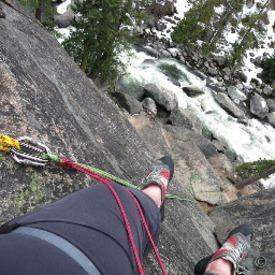Why Cycling is Bad for Bone Density and How You Can Improve It

NorthCascades
Posts: 10,968 Member
What the Research Shows
If you are a road cyclist, especially if you train hard or have been training for multiple years, you are more likely to develop osteopenia or osteoporosis. This puts you at a higher risk for fractures; a risk that continues to go up with age and training. More masters were classified as osteoporotic compared to age-matched, non-athletes, and the percentage of these increased significantly after a seven-year period.1 So, for those of you in this category, you are not only more likely to be at risk, but the risk factor is higher as you complete more years of cycling training.
In 2012, there was an extensive review of 31 studies on the subject2. The findings were that adult road cyclists who train regularly have significantly low bone mineral density in key regions. This was found to be true when comparing the cyclists to control populations of both athletes in other sports as well as non-athletes. Areas of the lumbar spine, pelvic and hip regions, and femoral neck were all key areas found to have lower values in road cyclists than the controls.

http://home.trainingpeaks.com/blog/article/why-cycling-is-bad-for-bone-density-and-how-you-can-improve-it
If you are a road cyclist, especially if you train hard or have been training for multiple years, you are more likely to develop osteopenia or osteoporosis. This puts you at a higher risk for fractures; a risk that continues to go up with age and training. More masters were classified as osteoporotic compared to age-matched, non-athletes, and the percentage of these increased significantly after a seven-year period.1 So, for those of you in this category, you are not only more likely to be at risk, but the risk factor is higher as you complete more years of cycling training.
In 2012, there was an extensive review of 31 studies on the subject2. The findings were that adult road cyclists who train regularly have significantly low bone mineral density in key regions. This was found to be true when comparing the cyclists to control populations of both athletes in other sports as well as non-athletes. Areas of the lumbar spine, pelvic and hip regions, and femoral neck were all key areas found to have lower values in road cyclists than the controls.

http://home.trainingpeaks.com/blog/article/why-cycling-is-bad-for-bone-density-and-how-you-can-improve-it
0
Replies
-
What constitutes "training hard", "training regularly", "low level cyclist" and "training at high levels" as far as that research goes?
It may well be in the source material, but the summary doesn't quantify any of that. I think we can safely say that Tour riders or Olympic sprinters fall into the "training hard / at high levels" group, but where is the transition between recreational/low level cyclists and high level?
I'm pretty confident I don't fit in the "high levels" group (and I'm weight training as well, anyway), but it would be helpful to know where the boundary is, particularly for others who clocking up higher mileage or more serious training0 -
It's not the case that those who "train hard / at high levels" have a problem and it doesn't apply to the rest of us. The question is where each of us falls on the spectrum.
I don't think there's much value in quantifying what those terms mean exactly. If you want to know what your specific bone density is, get a scan. This is sort of like how "zones" simplify heart rate or power numbers, the exact value doesn't really matter, what bracket you're in matters.
What we can do: lift weights. run. walk, or hike. jump. play competitive group sports (basketball, football, etc). These things would benefit you even if your risk for osteoporosis wasn't elevated - but it is, so these will help you a lot.0 -
Thanks for that link.
My main training partner and I have been incorporating Stronglifts 5x5 into the early winter season prior to race training starting back up. I'd like to continue it alongside my bike training, I'm just having a hard time finding any good information about how and when to do that without negatively impacting my on-bike training.0 -
I've been doing something a lot like SL 5x5. I've personally been skipping the leg stuff; I'm a cyclist in a hilly place, I can bench press my watch and I can leg press my car. It's my upper body where I want to build muscle. When I do squats, my cycling suffers the next day, I'm slower, and sorer. I've always felt like "leg day" isn't really necessary for us. I've had good results this way, my girlfriend is happy, I have more muscle mass now which is good for weight maintenance, etc.
This article says I'm doing it wrong and should be doing squats even if only to strengthen my hip bones. I've heard too many stories about young cyclists breaking their hips in fairly minor crashes and falls. I'm going to have to rethink my position.0 -
when I started my weight loss regime, my doctor referred me to the local hospital for regular Dexa scans to keep track of bone density - he was worried that losing the large amount of mass I had to diet away was going to mean I was on a restricted diet for a long period of time (quite correctly - I lost the bulk of the problem mass in jsut under 2 years, but here I am 3 years later (5 years in total) and still not at the weight we originally targetted!
Reason for the concern was simple - I've already had a fractured pelvis (3 places) and smashed femur from a prior accident (not bone density related - more the result of hitting a temporary traffic light at 30+mph, as propelled by getting hit by a large ford van), plus my mother suffered from Osteoporosis, and my dad managed to break both Hip Joints in 2 seperate falls... so they were concerned about possible genetic traits towards these issues.
However, the Dexa Scans showed that there was nothing major to worry about - though as I basically cut out pretty much all dairy, the doc did put me on a calcium supplementation regime. At first, I wasn't really able to add in much in the way of weight bearing exercises other than simply hefting my near 400lb frame around while walking - and even now, if I'm honest, I probably don't really do enough "impact" generating exercises - maybe another 40lb or so and I'll start with something more impact producing, but in deference to my knees at my current weight, it's unlikely...
0 -
What constitutes "training hard", "training regularly", "low level cyclist" and "training at high levels" as far as that research goes?
It may well be in the source material, but the summary doesn't quantify any of that. I think we can safely say that Tour riders or Olympic sprinters fall into the "training hard / at high levels" group, but where is the transition between recreational/low level cyclists and high level?
I'm pretty confident I don't fit in the "high levels" group (and I'm weight training as well, anyway), but it would be helpful to know where the boundary is, particularly for others who clocking up higher mileage or more serious training
@35dollars
From the article "Included in this review were only a few studies involving amateur or low-level cyclists. Differences in bone mass were not found between the cyclists and controls when comparing with low level cyclists. "
There's a lot of unqualified statements "less", "more likely", "high levels" etc.... (To what degree less or more likely? What is high?)
So yes it's an interesting article but the application is very personal. I've only been cycling seriously for a few years, I'm not lightweight (one of the risk factors), I do a significant amount of strength training, my fractures have only come from severe blunt force trauma (rugby, motorcycle crashes), I've walked away from lots of high impacts without fractures, I don't recover from long rides by sitting or laying around!
0 -
Interesting.0
-
Any form of exercise will not be "all things to all people." We differ individually. Some people will never be affected no matter how much they bike: others will be subject to osteoporosis merely by their genetic background. I would suggest supplementing bicycling with cross-training activities that challenge what biking doesn't (as upper body, core, etc.) Having a regimen of regular stretching is also crucial particularly as one ages. Each of us is unique and our fitness regimen needs to reflect that.0
This discussion has been closed.





